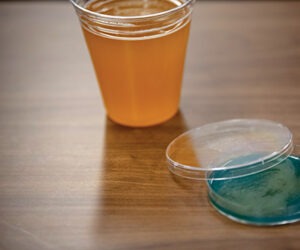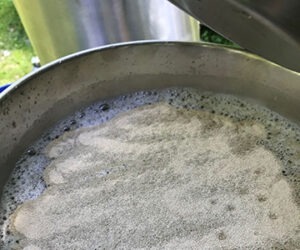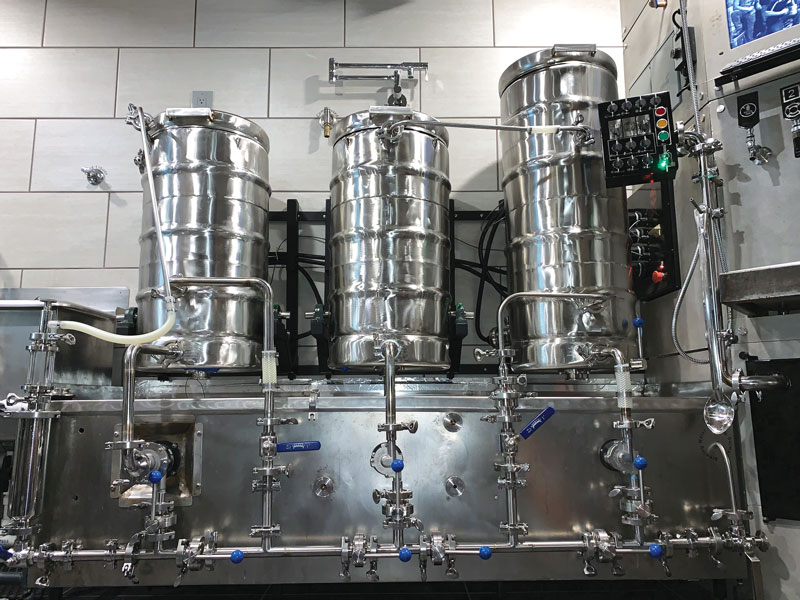Final Gravity Woes & Hop Bursting: Mr. Wizard
Q
I am an all-grain brewer who cannot seem to hit my final gravity on any of my brews. I just finished a stout that should have gotten down to about 1.020 specific gravity even with the roasted grains, but it stopped at 1.037 after two weeks. I am aerating my wort with an air pump and air stone, I am using a yeast starter, adding yeast nutrient, and using a temperature controlled freezer with a conical fermenter. I don’t know what I am doing wrong!
Jason Manzano
via email
A
This is a difficult question to address because there are some important facts that are missing, such as wort original gravity (OG), grist bill, mashing method, yeast strain and fermentation temperature. But your problem is not uncommon to many new brewers and some general advice may help you with continuing to brew batches of beer that don’t seem to finish.
I really want to know the wort OG because this has a real influence on the final gravity. A good rule of thumb for estimating expected final gravity is to multiply the number of gravity points in your wort (or °Plato for those like me who use Plato) by 0.2–0.25. For example, if the OG of this batch were 1.080 (80 gravity points) I would expect the batch to finish somewhere between 1.016 and 1.020. If the OG was actually 1.110, for example, the expected final gravity would be 1.022–1.028. If the recipe indicated something different from this range I would question the accuracy of the recipe. In your case, this brew really finished high and there is a problem beyond the obvious.
Culprit number one on my list is the grist bill, in particular the special malts that you used for your stout. I am assuming now that you either are an all-grain brewer or you used extract with some special malts added. High percentages of caramel/crystal malts in the grist will certainly increase the finish gravity because these malts contain a much higher percentage of non-fermentable carbohydrates than do paler malts that have been mashed. This is due to the formation of Maillard reaction products during the production of these special malts. If you used large additions of special malts, that could explain part of the problem.
Assuming that you brewed your stout using all-grains and no extracts, the high final gravity could be the result of an excessively high infusion mash temperature, too short of a mash at the proper temperature (148–158 °F; 65–70 °C), excessively thick mash or mash pH out of the range of 5.2–5.5. The goal of mashing is the conversion of starch to fermentables and it is very important to accomplish the goal through careful control of all variables that influence conversion.
Then there is the yeast strain and fermentation temperature. It is good that you aerated your wort using a rig that should do a good job, you used yeast nutrients and used a starter for the yeast. These are all things that should help ensure a healthy fermentation. But even when you perform all of these procedures properly, it is still possible to have problems if you selected a finicky strain that flocculates early, has a tendency of hanging up, like some saison strains, or has a particular temperature affinity. I
honestly doubt that you have a yeast problem due to the care it sounds like you seem to have taken, but it is certainly a very common cause of fermentation issues.
Q
I keep reading about “hopbursting” as a method, but can’t seem to find any detailed definition of it — let alone a technique. So what is hopbursting and what can I expect from this technique? Who uses it? How can I implement it?
Matt Reilly
Washington, DC
A
I must admit Matt that this is a method I have not heard of, until doing a little research to help me with an answer. The cool thing about homebrewing is that techniques often take on interesting names, and in the case of “hopbursting” made my research a little easier. This is in contrast to methods used by commercial brewers that frequently are used generically. I think the reason for this is that commercial brewers often develop methods that are viewed as “trade secrets” and as such are not named.
Mitch Steele, former Brewmaster of Stone Brewing, helped me out on this one by digging around in the San Diego homebrew community and talking to Jamil Zainasheff, who has used this method. Here is what Jamil explained about it:
“Long ago I ran across a few commercial beers that were massively late hopped and had little or no bittering charge. The aroma wasn’t anything more than you would expect from dropping in massive amounts of hops near the end of the boil, but the bittering had a “softer” character. It seemed to me at the time that boiling hops for a longer time not only resulted in more isomerized hop acids, but a harsher bittering the longer you boiled them. By switching to a shorter boil and a greater quantity of hops, you got a softer bittering and more hop character because you tossed in lots of late hops.
“I tried this when homebrewing for an article for Zymurgy a while back, and also had a number of other folks try the same thing. We used a standard boil time (60 to 90 minutes), a very small or no early hop addition (a few IBU at most), massive hopping the last 10 to zero minutes, and then rapidly chill the entire wort with an immersion chiller. Quick chilling of the entire wort retains more of the hop character. Of course, you are limited to how many IBU you can get so a really high IBU beer with this method is tough.
“In our initial commercial batches we tried this on a beer, adding massive hops at the end of the boil. Unfortunately, the hot stand in the whirlpool and during knockout was so long that we were getting 70 IBU even with no other additions. We switched to pre-chilling our water and also moved a lot of the hops over to dry hopping to get the IBUs down into the 40–50 range. The only issue is that dry hopping doesn’t give the same character as late kettle hops. In our new brew plant we’re going to try a hopback to see if we can get more of that late addition character instead.”
I was just at the Craft Brewers Conference in San Diego and picked up some information related to the topic of new beers and brewing techniques. You ask who uses a method like hopbursting and why. A talk I listened to about Gen Y gives some insight into this general question. We know about the origins of this particular technique, but what about boundary pushing things in general? Many of these new methods are developed by brewers who want to try something completely contrary to conventional wisdom; apparently this is one of the traits of the Gen Y crowd. The “why” originated as simply doing something different in the kettle for a specific purpose, and this evolved into a method that delivers an intense hoppiness that is different than adding hops early in the boil for bitterness followed by aroma hops added late in the boil.
On a very practical note, Mitch commented that it may be a good idea to add a very small hop addition to the kettle when the boil begins, or right before the boil, to help control foaming. This is indeed sound advice since unhopped wort foams much more intensely than hopped wort. Like the old Dippity Do adds, a little dab will do you. If you are concerned about adding too much bitterness, select a low alpha variety for this purpose.
Many of the hop bombs I sampled while in San Diego during the CBC had hop intensities that defy normal brewing techniques. The Palate Wrecker brewed by Green Flash Brewing is one example of a brew with very high hop bitterness, coupled with aromas and flavors that I have never tasted in a brew that was simply “highly hopped.” Some of these beers are being brewed with unbelievably high hop charges approaching 1⁄10th pound per gallon! I like to think the name hopburst may have been inspired by Green (hop?) Flash (burst?). I imagine that some creative naming may follow a tasting session of some of these monsters!
Being one of those brewers who likes to calculate things, large late additions presents a conundrum in my math. One can assume that hops boiled for 20–30 minutes have a utilization of somewhere around 15–20%, but what about hops added 5–10 minutes before the end of the boil? Depending on how long the hot wort is held to help settle hop solids the utilization reports found in the literature vary from about 5–15%. This makes it very difficult to “accurately” calculate late hop additions if you want to hit a target bitterness level. I think most brewers who are brewing these hoppy giants are more than likely relying on empirical methods more than anything. If the last brew had 30 pounds (14 kg) of hops dumped into a 10 BBL (310-L) batch and it turned out well, the next batch may contain 33 pounds (15 kg) because a 10% increase “feels right”.
I was still trying to wrap my mind around this “hopbursting” method when I listened to a talk presented by Dr. Tom Shellhammer from Oregon State University. Some of the data presented directly relates to this topic and raised some interesting ideas. For starters, Tom discussed how the “old school” IBU method, where iso-octane is used to extract iso-alpha acids from beer, responds to more than simply iso-alpha acids. For example, polyphenols and alpha acids from hops directly affect the results of the IBU measurement. Many brewers assume that 1 IBU corresponds to 1 mg/L of iso-alpha acids, and the data presented in Dr. Shellhammer’s talk clearly showed that this is not correct. As it turns out, the error becomes greater when huge late hop additions are made since late additions increase the polyphenol content of wort and beer more than early additions (polyphenols precipitate with proteins during boiling) and late additions also increase the amount of alpha acids present in wort and beer. Neither class of compounds significantly contribute to beer bitterness, meaning that the increase in IBUs measured using the iso-octane method is misleading.
I realize that I am drifting off topic, but this is interesting to me! Tom reported that this error is not seen when a more specific method is used to quantify iso-alpha acids in beer is used. The current standard accepted by the American Society of Brewing Chemists (ASBC) and the European Brewing Convention (EBC) is based on high performance liquid chromatography (HPLC). The HPLC method accepted by both the ASBC and EBC separates the constituents of beer using a chromatographic column and a detector to quantify the concentrations of the various compounds that are eluted from the column during the course of the run.
The interesting thing with all of this is that very few small breweries have HPLCs in their labs and do not use this method for measuring IBUs in beer. The iso-octane method, however, is pretty easy to perform if you have a UV spectrophotometer. The punch line is that an IBU is not an IBU . . . it depends on the method used in the lab. Most of you are probably thinking, “what’s the big freaking deal, so what?” The big deal is that IBUs have become a bragging right in the community of extreme brewers. And based on the data I saw at the CBC I am thinking that some of the claims of very high IBUs, some as high as 150, are due to errors in the iso-octane method.
My point with all of this is that beers brewed by adding lots of hops late in the boil do indeed have interesting and different hop characters. But this method in general is a bit too new for much math to be available to help the brewer when it comes to beer formulation. This is one of those times when you need to rely on good notes, experimentation, patience and persistence to end up with the type of beer you seek. I saw an interesting show recently about the evolution of the guitar during the 20th century. Things got pretty interesting when the electric guitar was invented and then amped. Feedback was discovered and this led to the development of all sorts of pedals. None of these things could be put on paper with the musical notations used for centuries by composers, but that did not stop musicians like Jimi Hendrix from developing a whole new sound and style of guitar playing. I think this hopbursting method may be the brewing equivalent of feedback. As Wayne may have said, brew on, Garth!



